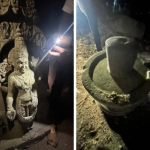Japan Addresses Tourist Misconduct: Mount Fuji View to be Blocked
The resort town of Fujikawaguchiko, located at the base of Japan’s iconic Mount Fuji, has announced plans for the country’s tallest mountain— Mount Fuji view to be blocked. They have decided to construct a massive barrier to mitigate the disruptive behaviour of foreign tourists. The decision comes as a reaction to increasing reports of littering, illegal parking, and trespassing on private properties by visitors seeking the ideal snapshot of Japan’s renowned volcano.
The barrier, a 2.5-meter-tall mesh net stretching 20 meters in length, will be installed within the next week, according to town officials. This move is intended to restrain the disruptive behaviour of tourists who have been gathering at a well-known location adjacent to a Lawson convenience store. This spot became popular on social media for its unique contrast of a modern convenience store with the traditional setting of Mount Fuji. The popularity of this spot has led to a surge in large crowds, causing traffic issues, safety hazards, and inconvenience to local businesses.
Despite many attempts to manage the growing crowds through traffic signs and security personnel, issues continued to escalate. Some tourists went as far as climbing onto the roof of nearby buildings to get a better view, prompting local authorities to act. The barrier aims to deter tourists from gathering at the site and is intended to remain in place until the situation improves.
This move is part of Japan’s larger attempt to tackle over-tourism, which has increased significantly since pandemic travel restrictions were lifted. Earlier this year, Kyoto’s well-known geisha district in Gion began restricting access to certain narrow alleys to address rude conduct, and authorities in Yamanashi Prefecture introduced a 2,000-yen fee for hikers using the busiest and most popular trail to climb Mount Fuji. The fee, which will be implemented this summer, aims to reduce overcrowding on the mountain.
The town officials acknowledge that the booming tourism, with over three million visitors arriving in March alone, boosted Japan’s economy. However, they expressed regret over having to take harsh measures, as the rapid growth in visitor numbers has started to put a strain on local communities. While the installation of a barrier might seem severe, officials emphasize that it was a last resort after other efforts had failed to control unruly behaviour.
Japan isn’t alone in taking these kinds of measures. Other popular destinations like Venice and Bali have also started to draw boundaries to tackle mass tourism—Venice with a fee for day-trippers, and Bali with a tourist tax to manage environmental impact. The new barrier in Fujikawaguchiko is a clear signal that destinations are seeking innovative ways to balance economic benefits from tourism with the need to maintain order and respect for local communities.
As Japan navigates the complexities of over-tourism, this new barrier at Mount Fuji brings light to the ongoing struggle to find harmony between welcoming visitors and preserving the quality of life for residents. It serves as a strong reminder that responsible tourism is needed to keep things sustainable for both tourists and locals.
Suggested Read: 400 Year Old Bronze Statue Of Vishnu Found In Haryana
Suggested Read: IRCTC Launches Economy Meals At INR 20 to 100 Stations
Suggested Read: New Rules For Schengen Visa
Suggested Read: Day Tickets In Venice Introduced Amidst Overcrowding





